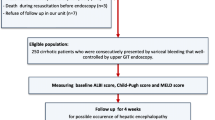Abstract
Other investigators have found that in adults the Serum-Ascites Albumin Gradient (SAAG) to be 1.1 g/ dl or greater in the presence of portal hypertension (PTHN) and less than that in its absence. We sought to determine the correlation between the level of SAAG and the complications of PTHN, manifested by the presence of esophageal varices in children with ascites. Our study included 26 patients with cirrhosis, diagnosed by liver biopsy and 14 patients with nephrotic syndrome (NS) diagnosed by established criteria. The SAAG was measured in all patients. The patients with cirrhosis had upper gastrointestinal (Gl) endoscopy for assessment of esophageal varices (EV). We found that 84.6% (22 of 26) patients with cirrhosis had High SAAG (≥1.1 g/dl) and 15.4% (4 of 26) had low SAAG (<1.1 g/dl) (p < 0.001). EV was found in 91% (20 of 22) patients with high SAAG and in 50% (2 of 4) patients with low SAAG (p = 0.013). The SAAG differentiated cirrhosis with EV from those without EV (sensitivity = 91%, specificity = 50%, positive predictive value = 91%, negative predictive value = 50% and efficacy = 85%).The high SAAG is a useful means to predict the presence of EV in children with ascites.
Similar content being viewed by others
References
Fitzgerald FJ. Ascites. In Wyllie R, Hyams SJ, eds.Pediatric Gastrointestinal Diseases : Pathaphysiology, Diagnosis and Management, first edn, 1993:151–152.
Mowat AP. Portal hypertension in children. In Liver Disorders in childhood, 4th edn, Butterworth and Company 1994; 189–196.
Valeta EA, Loreti S, Cipolli Met al. Portal hypertension and esophageal varices in cystic fibrosis; unreliability of echo-Doppler flowmetry.Scand J Gastroenterol 1993; 28: 1042–1046.
Hoef JC. Serum protein concentration and portal pressure determine the ascitic fluid protein concentration in patients with chronic liver disease.J Lab Clin Med 1983; 102: 260–273.
Runyon BA, Montano AA, Akrivadis EAet al. The serum-ascites albumin gradient in the differential diagnosis of ascites is superior to the exudatetransudate concept.Ann Intern Med 1992; 117: 215–220.
Rector EG, Reynolds TB. Superiority of serum-ascites albumin difference over the ascites total protein concentration in separation of transudative and exudative ascites.Am J Med 1984; 77: 83–85.
Pare P, Talbot J, Hoefs JC. Serum-ascites albumin concentration gradient: a physiologic approach to the. differential diagnosis of ascites.Gastroenterology 1983; 84: 240–244.
Kajani MA, Yoo YK, Alexander JAet al. Serum-ascites albumin gradients in nonalcoholic liver disease.Dig Dis Sci 1990; 35: 33–37.
Mauer K, Manzione NC. Usefulness of serum-ascites albumin difference in separating transudative from exudative ascites. Another look.Dig Dis Sci 1988; 33: 1208–1012.
Sherlock S. Ascites. In Sherlock S, Dooley J, eds.Disease of the Liver and Biliary System, 9th edn. Oxford Blackwell Scientific Publication, 1993 :114–131.
Witte MH, Witte CL, Dumont AF. Estimated net transcapillary water and protein flux in the liver and intestines of patients with portal hypertension from hepatic cirrhosis.Gastroenterology 1980; 80: 265–272.
Hoef JC, Jonas GM. Diagnostic paracentesis.Adv Int Med 1992; 37: 391–409.
Runyon BA. Care of patients with ascites.N Engl J Med 1994; 330: 337–342.
Runyon BA. Ascites and spontaneous bacterial peritonitis. In Sleisenger MH, Fordtran JS, eds.Gastrointestinal Disease: Pathophysiology, Diagnosis, Management. Vol II. Philadelphia; W.B. Saunders Company, 1993; 1977–2003.
Das B, Acharay U, Purohit A. Comparative utility of sero-ascites albumin gradient and ascitic fluid total protein for differential diagnosis of ascites.Indian Pediatr 1998; 542–545.
Bergstein MJ. Nephrotic Syndrome. In Behrman ER, Kliegman MR, Arvin MA, eds.Nelson Textbook of Pediatrics, 15th edn. W.B. Saunders Company, 1996 : 1500.
Alvarez F, Bernard O, Brunelle Fet al. Portal obstruction in children. Clinical investigation and hemorrhage risk.J Pediatr 1983; 103: 696–702.
Beppu K, Inokuchi K, Koyagani Net al. Prediction of variceal hemorrhage by esophageal endoscopy.Gastrointest Endosc 1981; 27: 213–218.
Spencer RJ, Sloan JM, Johnston GW, Greenfield A. Esophageal mucosal changes in patients with varices.Gut 1983; 24: 1024–1029.
Ament ME, Christie DL. Upper gastrointestinal endoscopy in pediatric patients.Gastroenterology 1977; 72: 1244–1248.
Author information
Authors and Affiliations
Corresponding author
Rights and permissions
About this article
Cite this article
Das, B.B., Purohit, A., Acharya, U. et al. Serum-Ascites Albumin Gradient: A predictor of esophageal varices with ascites. Indian J Pediatr 68, 511–514 (2001). https://doi.org/10.1007/BF02723242
Issue Date:
DOI: https://doi.org/10.1007/BF02723242




